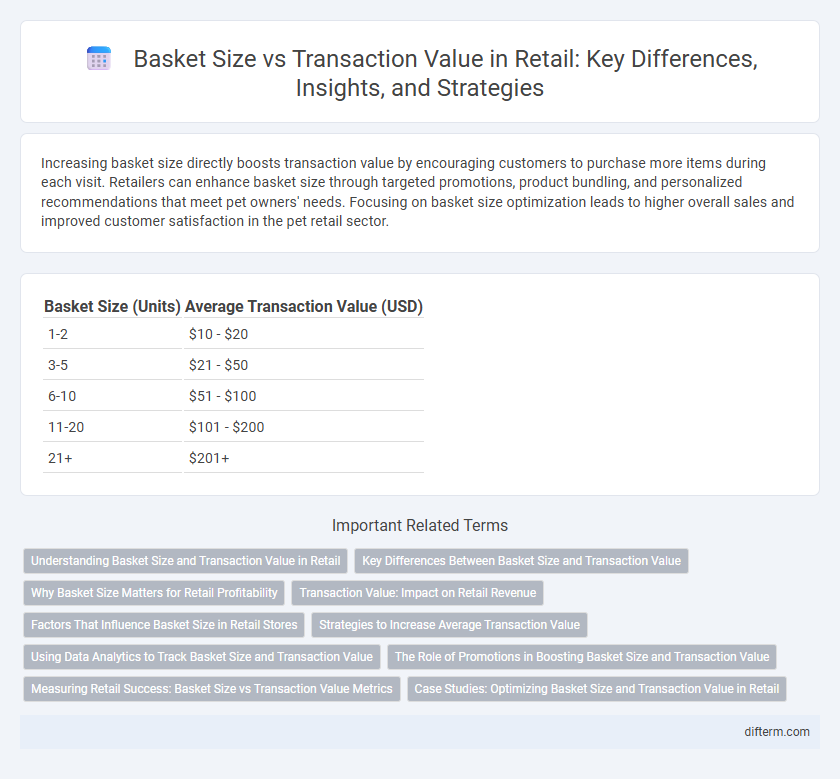Increasing basket size directly boosts transaction value by encouraging customers to purchase more items during each visit. Retailers can enhance basket size through targeted promotions, product bundling, and personalized recommendations that meet pet owners' needs. Focusing on basket size optimization leads to higher overall sales and improved customer satisfaction in the pet retail sector.
Table of Comparison
| Basket Size (Units) | Average Transaction Value (USD) |
|---|---|
| 1-2 | $10 - $20 |
| 3-5 | $21 - $50 |
| 6-10 | $51 - $100 |
| 11-20 | $101 - $200 |
| 21+ | $201+ |
Understanding Basket Size and Transaction Value in Retail
Basket size in retail refers to the number of items purchased in a single transaction, which directly influences the transaction value, the total monetary amount spent by the customer. Increasing basket size through strategic product placement, promotions, and personalized offers can significantly boost the average transaction value and overall sales revenue. Retailers analyzing basket size alongside transaction value gain insights into customer purchasing behavior, enabling targeted marketing and inventory optimization.
Key Differences Between Basket Size and Transaction Value
Basket size refers to the number of items purchased in a single transaction, while transaction value measures the total monetary amount spent by the customer during that purchase. Basket size focuses on quantity, providing insights into consumer purchasing behavior, whereas transaction value highlights revenue generated per transaction, emphasizing financial performance. Understanding the distinction helps retailers optimize sales strategies by balancing product mix and pricing to maximize profitability.
Why Basket Size Matters for Retail Profitability
Basket size directly influences transaction value, impacting overall retail profitability by increasing average spend per customer. Larger basket sizes reduce fixed costs per unit, enhancing margin efficiency and boosting revenue without proportional increases in operational expenses. Retail strategies that encourage higher basket sizes, such as product bundling and personalized recommendations, lead to improved profitability through increased customer lifetime value.
Transaction Value: Impact on Retail Revenue
Transaction value directly influences retail revenue by reflecting the total amount spent per purchase, highlighting consumer purchasing power and spending behavior. Larger transaction values often indicate successful upselling and cross-selling strategies, which boost overall profitability without increasing customer visits. Retailers analyzing transaction value trends can optimize pricing, promotions, and product placement to maximize revenue growth effectively.
Factors That Influence Basket Size in Retail Stores
Basket size in retail stores is primarily influenced by product assortment, pricing strategies, and store layout, which encourage customers to add more items per visit. Promotions, loyalty programs, and seasonal campaigns also play critical roles in increasing the number of items purchased, directly impacting the average transaction value. Furthermore, consumer demographics and shopping behavior, such as impulse buying tendencies and time spent in-store, significantly affect basket size and overall transaction revenue.
Strategies to Increase Average Transaction Value
Increasing basket size directly boosts average transaction value by encouraging customers to purchase more items per visit. Effective strategies include upselling complementary products, offering volume discounts, and implementing personalized recommendations based on customer buying behavior. Leveraging in-store promotions and optimizing product placement can also stimulate higher spending during each transaction.
Using Data Analytics to Track Basket Size and Transaction Value
Data analytics enables retailers to accurately track basket size and transaction value by analyzing purchase patterns, customer behavior, and product preferences. Leveraging point-of-sale data and advanced algorithms provides insights into average items per transaction and revenue generated per customer visit. This information helps optimize inventory management, tailor promotions, and improve pricing strategies to increase overall sales performance.
The Role of Promotions in Boosting Basket Size and Transaction Value
Promotions play a critical role in increasing both basket size and transaction value by incentivizing customers to purchase more items per visit. Limited-time discounts, bundle offers, and loyalty rewards encourage shoppers to add complementary or higher-priced products to their carts, directly impacting average spend. Retailers leveraging targeted promotional strategies see measurable uplifts in sales metrics, driving overall revenue growth and enhancing customer lifetime value.
Measuring Retail Success: Basket Size vs Transaction Value Metrics
Measuring retail success involves analyzing basket size, the average number of items per transaction, alongside transaction value, the total monetary amount spent. Increasing basket size often indicates higher customer engagement and product interest, while boosting transaction value reflects effective pricing strategies and upselling techniques. Optimizing both metrics enhances profitability and provides deeper insights into consumer behavior and purchasing patterns.
Case Studies: Optimizing Basket Size and Transaction Value in Retail
Case studies in retail demonstrate that increasing basket size directly correlates with higher transaction value, driving overall revenue growth. Retailers employ data-driven strategies such as personalized promotions, product bundling, and loyalty programs to optimize basket composition and maximize purchase amounts. Analyzing consumer behavior patterns enables targeted interventions that enhance both average basket size and transaction value effectively.
basket size vs transaction value Infographic

 difterm.com
difterm.com